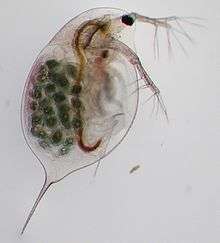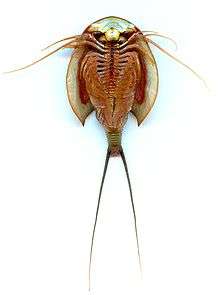Daphnia longispina
| Daphnia longispina | |
|---|---|
 | |
| Daphnia longispina - female adult | |
| Scientific classification | |
| Kingdom: | Animalia |
| Phylum: | Arthropoda |
| Subphylum: | Crustacea |
| Class: | Branchiopoda |
| Order: | Cladocera |
| Family: | Daphniidae |
| Genus: | Daphnia |
| Species: | D. longispina |
| Binomial name | |
| Daphnia longispina O. F. Müller, 1776 .[1] | |
Daphnia longispina is a planktonic crustacean of the genus Daphnia (Family "Daphniidae"), a cladoceran freshwater water flea. It is native to Eurasia. D. longispina is similar in size and sometimes confused with the often sympatric D. pulex (a very common species), but much smaller than D. magna.[2] D. longispina is found in a wide range of standing freshwater bodies from small, ephemeral rock-pools to large lakes.[3][4]
Life history
Like all Daphnia species, D. longispina is a filter feeder, collecting particles of about 2 to 40 µm suspended in the water.[5] The main food are green algae. At 20 °C maturity is reached within about 6 to 12 days, followed by a period of regular reproduction in about 3-4 day intervals. D. longispina reproduces either asexually (parthenogenesis) or sexually. For the later, females need to produce sons asexually. The same or other females can switch at any moment from asexual to sexual reproduction, but producing haploid eggs, which require fertilization by males. The sexual eggs are then deposited in an ephippium (plural: ephippia, a resting egg shell), which will sink into to the bottom of the water body when the female molts her carapace. After a resting period, which can last several years, the resting stages hatches. Only females emerge from the resting stages.[6][7]
Systematics and evolution
Within the genus Daphnia, D. longispina belongs to the subgenus Hyalodaphnia, sometimes called the D.longispina complex. Closely related species of D.longispina in this complex are D. galeata and D. cucullata, with which D. longispina frequently hybridises.[8][9] A revision of the species complex recently showed that the species D. rosea, D. hyalina and D. zschokkei belong to the species D. longispina, invalidating their species status.[10]
Parasitism
In contrast to other Daphnia species, (e.g. D. magna) only few parasites have been reported to infect D. longispina.[11][12][13] It is however frequently subject to colonization by epibionts, such as peritrich ciliates and algae [11]
References
- ↑ "Daphnia longispina". Integrated Taxonomic Information System.
- ↑ Benzie, J. A. H. (2005). Cladocera: The genus Daphnia (including Daphniopsis). Backhuys Publisher,.
- ↑ Pajunen, V. I.; I. Pajunen (2007). "Habitat characteristics contributing to local occupancy and habitat use in rock pool Daphnia metapopulations". Hydrobiologia. 592: 291–302. doi:10.1007/s10750-007-0769-4.
- ↑ Smirnov (2014). The physiology of the Cladocera. Academic Press, Amsterdam.
- ↑ Lampert, W. (2011). Daphnia: development of a model organism in ecology and evolution. Oldendorf/Luhe: Internat. Ecology Inst.
- ↑ Smirnov, N. N. (2014). The physiology of the Cladocera. Academic Press, Amsterdam.
- ↑ Ebert, D. (2005). Ecology, epidemiology and evolution of parasitism in Daphnia. Bethesda (MD): National Library of Medicine (US), National Center for Biotechnology Information.
- ↑ Petrusek, A.; J. Seda; J. Machacek; S. Ruthova & P. Smilauer (2008). "Daphnia hybridization along ecological gradients in pelagic environments: the potential for the presence of hybrid zones in plankton". Philosophical Transactions of the Royal Society B-Biological Sciences. 363: 2931–2941. doi:10.1098/rstb.2008.0026.
- ↑ Dlouha, S., A. Thielsch, R. H. S. Kraus, J. Seda, K. Schwenk, and A. Petrusek (2010). "Identifying hybridizing taxa within the Daphnia longispina species complex: a comparison of genetic methods and phenotypic approaches". Hydrobiologia. 643: 107–122. doi:10.1007/s10750-010-0128-8.
- ↑ Petrusek, A.; A. Hobaek; J. P. Nilssen; M. Skage; M. Cerny; N. Brede & K. Schwenk (2008). "A taxonomic reappraisal of the European Daphnia longispina complex (Crustacea, Cladocera, Anomopoda)". Zoologica Scripta. 37: 507–519. doi:10.1111/j.1463-6409.2008.00336.x.
- 1 2 Green, J. (1974). "Parasites and epibionts of Cladocera.". Transactions of the Zoological Society of London. 32: 417–515.
- ↑ Stirnadel, H. A.; D. Ebert (1997). "Prevalence, host specificity and impact on host fecundity of microparasites and epibionts in three sympatric Daphnia species". Journal of Animal Ecology. 66: 212–222. doi:10.2307/6023.
- ↑ Bengtsson, J.; D. Ebert (1998). "Distribution and impacts of microparasites on Daphnia in a rockpool metapopulation". Oecologia (Berlin). 115: 213–221. doi:10.1007/s004420050510.
General references
- Benzie, J. A. H. (2005). Cladocera: The genus Daphnia (including Daphniopsis). Backhuys Publisher,.
- Ebert, D. (2005). Ecology, epidemiology and evolution of parasitism in Daphnia. Bethesda (MD): National Library of Medicine (US), National Center for Biotechnology Information.
- Lampert, W. (2011). Daphnia: development of a model organism in ecology and evolution. Oldendorf/Luhe: Internat. Ecology Inst.
- Smirnov, N. N. (2014). The physiology of the Cladocera. Academic Press, Amsterdam.
- Frederick Schram (1986). Crustacea. Oxford University Press. ISBN 978-0-19-503742-5.
External links
| Wikimedia Commons has media related to Cladocera. |
| Wikimedia Commons has media related to Branchiopoda. |
| Wikispecies has information related to: Daphnia |
